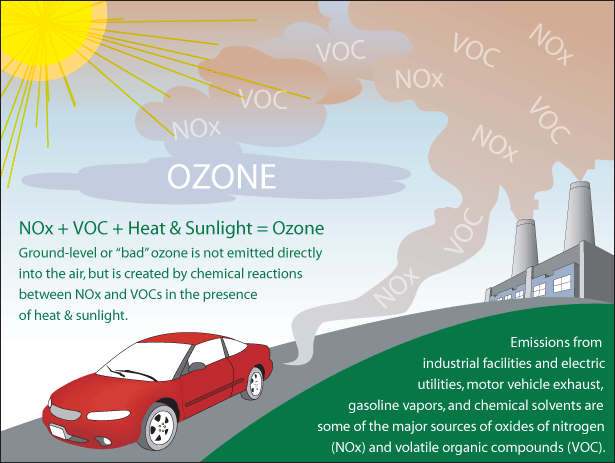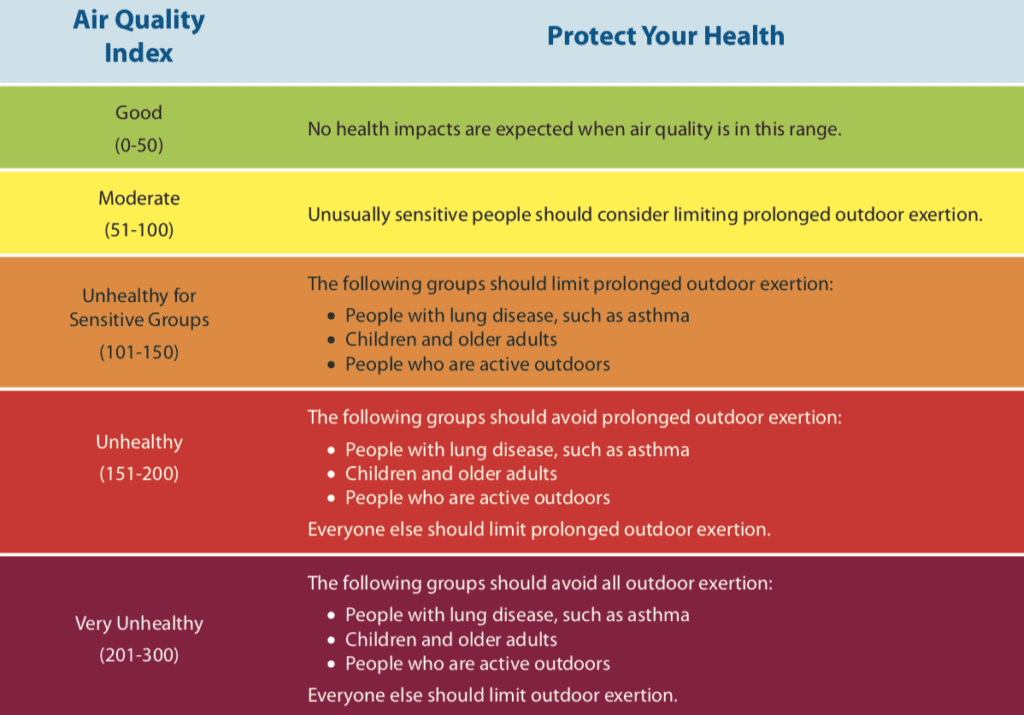Ozone (O3)
Ground level ozone (O3) can be deadly and the impact on our ecosystem is substantial and can be avoided. Check out the facts below:
The Facts
- 1 million premature deaths are attributed to fossil fuel-related ozone pollution annually. (#1)
- An increase in 3 parts-per-billion long-term O3 exposure is equal to the association of 29 pack-years of smoking or 3 years of aging. (#8)
- Ozone from fossil fuels is responsible for 7.7 million asthma-related trips to the emergency room each year. (#1)
- More than 5.6 Million Asthma related emergency room visits at a cost of $1B annually. (#1)
- Mortality ranging from 0.15 to 0.49 million deaths per year (#2)
- Ozone-attributable deaths due to COPD mortality (#3)
- Ozone Generators that are Sold as Air Cleaners and they can cause serious health concerns! (#4)
- Breathing ozone can shorten your life! (#5)
- Excessive Ozone in the air can have a marked effect on human health. It can cause breathing problems, trigger asthma, reduce lung function and cause lung diseases. (#6)
- In 2019, the total value of the global ozone generator market reached over US $400M. Ozone generators generate ozone to “purify the air” that are at concentrations well above what is classified as “good” levels by the EPA, WHO or CDC. (#7)
- Toxicologic studies have shown that O3 causes persistent pulmonary inflammation and structural alterations throughout the lung that may play a role in chronic lower respiratory disease, including emphysema (#8)
- Ozone affects sensitive vegetation and ecosystems, including forests, parks, wildlife refuges and wilderness areas.
Stratospheric Ozone vs Ground Level Ozone
Stratospheric ozone protects the Earth’s surface from ultraviolet radiation from the sun and is good for our planet. However, ground level ozone is bad for us – it is form when NOx pollution reacts with chemicals called volatile organic compounds. Exposure to high levels of ozone can cause premature deaths, years of life lost and emergency room visits
According to the world health organization, in 2016, 91% of the world population was living in places where the WHO air quality guidelines levels were not met. Ozone is one of the four major gases in addition to particulate matter identified by the Environmental Protection Agency (EPA) that is used to create the Air Quality Index (AQI). The others are Nitrogen Oxides, Sulfur Dioxide and Carbon Monoxide.
The U.S. air quality index is published daily by the hour and sometimes in increments of 15 minutes for pretty much every region in the country. This information is especially important to you if you are susceptible to health issues when exposed to certain toxic gases. In-fact a lot of people depend on the published data to decide whether to go out or stay indoors or to go to a certain area of the city, park, beach, etc. So, having this data point is super – isn’t it? Well, there is a small problem…
The US is approximately 3.8M square mile. Most EPA detection stations are approximately 3-50 miles from where you are! So, the surrounding air you are breathing is simply NOT going to be the same as what is being published. In-fact, air quality can differ greatly from room to room, floor to floor, from your home to your neighbor’s home and so on. Bottom line, you have no clue whether you are breathing good air or toxic air in the spot you are and you simply can’t depend on what the EPA is publishing. But in the absence of personal surrounding air, the EPA data is most definitely the best thing… Until now! Read on to learn more!
How is Ozone Formed?
According to the California Air Resources Board, Ozone, an important component of smog, is a highly reactive and unstable gas capable of damaging living cells, such as those present in the linings of the human lungs. Ozone is a powerful oxidant – its actions can be compared to household bleach, which can kill living cells (such as germs or human skin cells) upon contact.

Tropospheric, or ground level ozone, is created by chemical reactions between oxides of nitrogen (NOx) and volatile organic compounds (VOC). This happens when pollutants emitted by cars, power plants, industrial boilers, refineries, chemical plants, and other sources chemically react in the presence of sunlight.
The image above was captured from the EPA Ozone website.
Ozone and its impact on our health
According to the Environmental Protection Agency, Ozone in the air we breathe can harm our health. People most at risk from breathing air containing ozone include people with asthma, children, older adults, and people who are active outdoors, especially outdoor workers. In addition, people with certain genetic characteristics, and people with reduced intake of certain nutrients, such as vitamins C and E, are at greater risk from ozone exposure.

Breathing ozone can trigger a variety of health problems including chest pain, coughing, throat irritation, and airway inflammation. It also can reduce lung function and harm lung tissue. Ozone can worsen bronchitis, emphysema, and asthma, leading to increased medical care. Ozone exposure has been associated with increase emergency room visits, years of life lost and premature deaths! Yes – death!
Ozone and its impact on Mother Earth and our Ecosystem

Ozone affects sensitive vegetation and ecosystems, including forests, parks, wildlife refuges and wilderness areas. Ozone can especially cause damage during the growing season. According to the EPA, the effects of ozone can then have negative impacts on ecosystems, including:
- loss of species diversity (less variety of plants, animals, insects, and fish)
- changes to the specific assortment of plants present in a forest
- changes to habitat quality
- changes to water and nutrient cycles.
According to Air Central Texas, reducing ground-level ozone can have the following impacts on vegetation:
- Protect forest communities
- Improve yields for timber and some crops, such as soybeans and winter wheat
According to World Resources Institute’s (WRI) mission is to move human society to live in ways that protect Earth’s environment and its capacity to provide for the needs and aspirations of current and future generations. According to WRI, from 2010 to 2012, for example, increased amounts of ozone reduced global yields of staple grains, such as wheat, rice and maize, by 227 metric tonnes. Further, “climate change only intensifies these impacts as rising temperatures and shifting weather patterns will increase the number of days with high ozone concentrations.”
Air Quality Index (AQI)
The EPA, WHO and CDC have all agreed upon a standard for measuring Ozone exposure concentration and it’s impact on your health! The standard is shown below obtained from the EPA website. But there is one BIG PROBLEM! Read on to the next section.

Health Experts Agree that the EPA standards for “Good” are not Good enough!
From JAMA to Greenpeace to CREA to EHP to many other scientific organizations are making the case that we need to revise the current standards to be stricter lowering the threshold between good and moderate, moderate to unhealthy.
Our Air
Our Nation’s Air. The U.S. Environmental Protection Agency (EPA) is committed to protecting public health by improving air quality and reducing air pollution. This annual report, entitled Our Nation’s Air, summarizes the nation’s air quality status and trends through 2017. JAMA
How AerNos is Making a Difference
So, how can AerNos help? We have developed a breakthrough nanomaterial-based sensor that can detect gases in the environment to the parts-per-billion (ppb) See “reference material” below on what ppb means. Never before the world has seen a tiny chip capable of providing meaningful information that directly relates to your health!
AerNos sensors are now available to research institutions around the world and they are using it to correlate air pollutants to human health concerns. We are also working with some of the largest companies around the world to bring our AerNos AerN2S gas sensing technology into your homes – by allowing your IOT gadgets (from smart speakers to wearables to security systems to air purifiers) to finally provide you more information about what you are breathing and what you can do about it. So, stay tuned – Soon, AerNos will be everywhere allowing you to know exactly what you are breathing.
Learn more about AerNos Products.
Reference Material:
#1: Greenpeace and CREA research Feb 2020; #2: (Anenberg et al. 2010; Fang et al. 2013b; GBD 2013Risk Factors Collaborators 2015; GBD 2015 Risk Factors Collaborators 2016; Lim et al. 2012; Silva et al. 2013, 2016a); #3: Environmental Health Perspective (EHP) 2017; #4: EPA; #5L: American Lung Association; #6: World Heatlh Organization (WHO); (#7) QY Research Feb 2020; #8 JAMA
ppb=Parts-Per-Billions; One ppb is like a drop of water in a Olympic-size swimming pool or one blade of grass in a football field.

